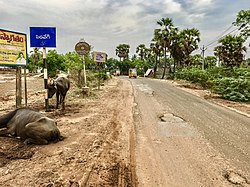Village in Andhra Pradesh, India
| Pedavegi Vengipuram | |
|---|---|
| village | |
 Pedavegi Village Board Pedavegi Village Board | |
| Dynamic map | |
  | |
| Coordinates: 16°46′15″N 81°06′14″E / 16.770809°N 81.103864°E / 16.770809; 81.103864 | |
| Country | |
| State | Andhra Pradesh |
| District | Eluru |
| Talukas | Pedavegi |
| Population | |
| • Total | 11,846 |
| Languages | |
| • Official | Telugu |
| Time zone | UTC+5:30 (IST) |
| PIN | 534450 |
| Telephone code | 08812 |
| Vehicle registration | AP |
Pedavegi is a village in Eluru district in the state of Andhra Pradesh in India, 10 km north of Eluru. It is administered under Eluru revenue division. Pedavegi also serves as the mandal headquarters of Pedavegi mandal. The nearest railway station is Denduluru (DEL) located at a distance of 9.15 km.
Etymology
It was formerly known as Vengipuram.
History

Peddavegi, historically known as Vengipura in West Godavari, served as the capital of the Salankayana, Vishnukundin, and Chalukyan dynasties from the 3rd to 11th centuries A.D. Coins from these dynasties have been found at the site. Huien Tsang mentioned a stupa built by Ashoka, which later lost significance during the Vishnukundin period and was replaced by Brahmanical temples. Excavations also revealed the ruins of the Parameshwara temple from the early Chalukyan period. Nearby, at Sankaram, rock-cut cells with Buddha figures were discovered, highlighting its importance as a monastic site.
Eastern Chalukyas, or Chalukyas of Vengi was a South Indian dynasty whose kingdom was located in present-day Andhra Pradesh. Their capital was Vengi and their dynasty lasted for around 500 years, from the 7th century until c. 1130 C.E. when the Vengi kingdom merged with the Chola empire. The Vengi kingdom continued to be ruled by Eastern Chalukyan kings under the protection of the Chola empire until 1189 C.E., when the kingdom succumbed to the Hoysalas and the Yadavas. Their capital was originally at present day Vengi (Pedavegi) of the West Godavari district but was later changed to Rajamahendravaram (Rajamundry).
Economy
National Palm Oil Research Centre is located in Pedavegi.
Demographics
As of 2011 Census of India, Pedavegi had a population of 11846. The total population consists of 6033 males and 5813 females with a sex ratio of 964 females per 1000 males. There are 1243 children in the age group of 0–6 years old. The average literacy rate stands at 71.18%.
See also
Notes
- Chakrabarti, Shakti (2013). Settlements Resource Use and Patterns of Communication in Early India C 200 B C 750 Ad. University of Delhi.
Peddavegi, located in the West Godavari district, was historically known as Vengipura. It served as the capital for the Salankayana, Vishnukundin, and Chalukyan dynasties from the 3rd to the 11th centuries A.D. Coins from these ruling powers have been discovered at Peddavegi. The Chinese traveler Huien Tsang mentioned a stupa at this site, said to have been built by Emperor Ashoka (IAR 1984-85:7). During the Vishnukundin period (5th-7th centuries A.D.), the stupa lost its significance and was replaced by Brahmanical temples constructed from soft red sandstone. Excavations from the early Chalukyan period revealed the ruins of the Parameshwara temple, with its basement exposed (Sarma 2000:16-17). Additionally, Sankaram, located southwest of Thotlakonda, was a significant monastic site from the early centuries A.D., where rock-cut cells containing figures of the Buddha were discovered (Fogelin 2006:103).
References
- "List of Sub-Districts". Census of India. Retrieved 25 May 2007.
- Murthi, G. V. Satyanarayana (1968). Abridgement and Reform of Telugu Script. Andhra University Press.
- "West Godavari district, irrigated by two mighty rivers, is on the road to agricultural prosperity thanks to various schemes". Retrieved 15 May 2017.
- "National Heritage Status". Retrieved 23 May 2017.
- "Pedavegi". Retrieved 23 May 2017.
This article about a location in Andhra Pradesh is a stub. You can help Misplaced Pages by expanding it. |